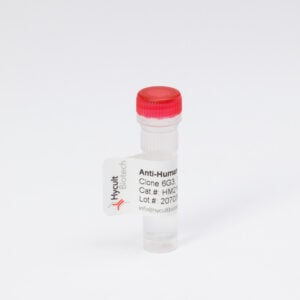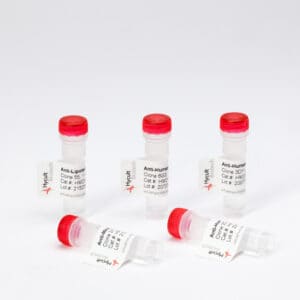Podoplanin, Human, clone LpMab12
€133.00 – €414.00
Monoclonal antibody LpMab12 recognizes Podoplanin. Podoplanin (PDPN), also known under the name Aggrus, is highly expressed in various tumors (such as oral, lung, esophageal, brain) and in normal cells as lymphatic endothelial cells and podocytes. PDPN is a small type-I membrane glycoprotein with a large number of O-glycoside chains and therefore it belongs to mucin-type proteins. It can be found on the surface of many types of normal cells originating from various germ layers. It is present primarily on the endothelium of lymphatic vessels, type I pneumocytes and glomerular podocytes. Increased levels of podoplanin or its neo-expression have been found in numerous types of human carcinomas, but it is especially common in squamous cell carcinomas, such as cervical, larynx, oral cavity, skin and lung cancer. This small sialomucin is also seen on the surface of cancer-associated fibroblasts (CAFs) in lung adenocarcinomas, as well as in breast and pancreatic tumors. In most cancers, a high level of podoplanin expression, both in cancer cells, as well as in CAFs, is correlated with an increased incidence of metastasis to lymph nodes and shorter survival time of patients. Little is known about the biological role of podoplanin, however research carried out on mice with a knock-out gene of this glycoprotein shows that the presence of podoplanin determines normal development of lungs, the lymphatic system and heart. Podoplanin on cancer cells and CAFs seems to play an important role in the development and progression of various cancers. Podoplanin possesses in its N-terminal extracellular region 3 tandem repeats of platelet aggregation-stimulating domains (PLAGs). The O-glycosylation on Thr52 of human PDPN (hPDPN) is critical for the interaction of hPDPN with C-type lectin-like receptor-2 (CLEC-2), resulting in platelet aggregation. LpMab12 detects sialylated O-Glycan on Thr52 in PLAG. It detects endogenous hPDPN by flow cytometry. The minimal epitope of LpMab12 is identified as Asp49-Pro53 of hPDPN. LpMAB-12 did recognize the glycosylated hPDPN synthetic peptide 38-54, but not the non-sialylated peptide. LpMab12 could serve as a diagnostic tool for determining whether hPDPN possesses sialylation on Thr52 or not.
. FC: HM2376 can be used both intra- and extracellular.
W: reduced and non-reduced conditions were used. The expected band sizes are ~40 kDa.







